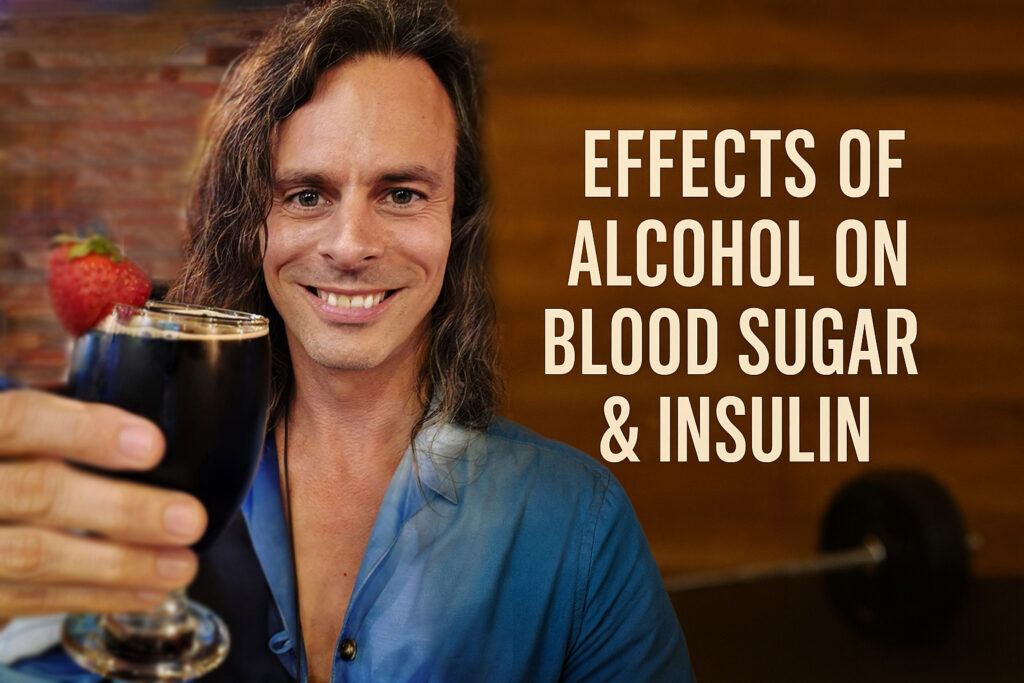Alcohol vs. Insulin Sensitivity: What One Drink Really Does — And How to Undo It
Your fasting glucose is dialed in. You’re chasing elite insulin sensitivity. Then you have one drink — is the damage done?
Follow me at tombirkenmeyer.com for real-world, science-backed strategies to keep your metabolism optimized — even when life includes a glass of wine or whiskey.
Whether it’s a shot of top-shelf tequila, a glass of red wine, a craft cocktail, or a cold beer — alcohol hits your metabolism in ways most people underestimate. If you’re pursuing aggressive insulin sensitivity and metabolic flexibility, this guide lays it all out: the good, the bad, and how to rebound fast.
How Alcohol Affects Blood Sugar, Insulin Sensitivity, Sleep & More
🔬 1. Blood Sugar Impact
Pure alcohol (vodka, whiskey, tequila without mixers) has zero carbs and often
- The liver halts glucose output to metabolize alcohol, risking overnight hypoglycemia
- It can impair your ability to access stored glycogen during training
- It’s a metabolic stressor, not a healing agent
Beer and cocktails: Typically high in carbs and sugar. Most beers range from 10–30g of carbs per serving. Cocktails made with juice, soda, or syrup can deliver 30–50g+ of sugar — spiking glucose and triggering an insulin surge.
Wine: Dry red or white wines have 1–4g of sugar per glass and a lower glycemic impact. However, wine still slows liver function and affects sleep and insulin pathways.
🔥 2. Insulin Sensitivity Takes a Hit
Even a single drink can reduce insulin sensitivity by 10–30% for up to 24 hours. This is due to:
- Alcohol-induced mitochondrial stress
- Increased oxidative load and systemic inflammation
- Reduced glucose uptake in muscle post-exercise
This impairs one of your most powerful tools — exercise-enhanced glucose disposal.
🧠 3. Neurological + Sleep Disruption
All alcohol (beer, wine, spirits) disrupts brain chemistry. Even one serving can:
- Suppress REM sleep and reduce deep sleep
- Increase nighttime cortisol and next-morning glucose
- Reduce next-day leptin and insulin sensitivity
Result: Even clean alcohol makes your blood sugar harder to control the next day due to poor sleep architecture.
💧 4. Liver + Gut Stress
Alcohol is:
- A liver stressor — it slows down glucose metabolism and insulin clearance
- A gut disruptor — it increases gut permeability (“leaky gut”), worsens inflammation, and can indirectly increase insulin resistance
Beer and wine: Higher in histamines, fermentation byproducts, and allergens. These can exacerbate inflammatory responses and gut barrier disruption.
⚖️ Top Shelf vs. Bottom Shelf — Does It Matter?
- Top-shelf spirits (100% agave tequila blanco, potato vodka like Chopin, Belvedere, Tito’s): low in congeners, additives, and sugar. Better for liver and gut.
- Craft cocktails or flavored liquors: Often contain syrups, sugars, coloring, and artificial sweeteners — all metabolic landmines.
- Cheap beer, boxed wine, well liquor: Usually packed with sugar, caramel color, methanol traces, and inflammatory agents.
Conclusion: Quality matters. But even the cleanest drink isn’t metabolically neutral.
🧭 Final Verdict: Is One Drink Aligned With Your Goals?
| Factor | One Shot (Top Shelf) | One Beer / Sugary Cocktail | Aligned with Goals? |
|---|---|---|---|
| Glycemic Response | Neutral / Flat | Spike + Crash | ✅ (if clean liquor only) |
| Insulin Sensitivity | Impaired 10–30% | Impaired 20–40% | ❌ |
| Mitochondrial Function | Reduced | Reduced + Inflammation | ❌ |
| Sleep Quality | Diminished (REM loss) | Diminished (REM loss) | ❌ |
| Liver & Gut Health | Mild stress | Moderate to severe stress | ❌ |
Verdict: Even one drink — wine, beer, cocktail, or neat spirit — slightly blunts your metabolic edge for 12–48 hours.
🛡️ If You Choose to Drink, Here’s How to Minimize the Damage
✅ 1. Pre-Drink Strategy
- Protein + Fiber Meal: Lentils, greens, tempeh — slows alcohol absorption
- Bitter Compounds (30–60 mins before): Dandelion tea, ginger, bitter melon, or non-alcoholic bitters to stimulate bile flow
- NAC (600–1200 mg): Supports glutathione production for alcohol detox
✅ 2. During the Drink
- Choose clean, high-end liquor: No mixers, just lime or sparkling water
- Sip water constantly: 1 glass of water per drink to flush toxins
✅ 3. Post-Drink Recovery (Immediately After)
- Activated Charcoal (500–1000 mg): Binds metabolites
- NAC + Milk Thistle: Support liver Phase II detox
- L-Theanine (100–200 mg) + Magnesium Glycinate (300–400 mg): Help restore sleep depth
- Electrolytes + Water: At least 24–32 oz water with added minerals
✅ 4. The Next Morning
- Fasted Zone 2 Cardio (30–45 min): Boosts insulin sensitivity, burns liver fat
- Cold Shower or Plunge: Mitochondrial recovery + cortisol reset
- High-Fiber Green Smoothie: Include chia, bitter melon, greens, berries
- Berberine (500 mg) or Bitter Melon Extract: Restore insulin signaling
- Midday nap or extra sleep: Rebuild sleep cycles disrupted by alcohol
📊 How Effective Is the Protocol?
| Function | Without Protocol | With Protocol |
|---|---|---|
| Insulin Sensitivity | -20 to -30% | -5 to -10% |
| Liver Detox Efficiency | Sluggish | 80–90% Restored |
| Sleep Architecture | Fragmented | 60–75% Restored |
| Metabolic Flexibility | Compromised | 85–90% Restored |
| Inflammatory Response | Moderate spike | Minimal to none |
Overall Recovery: 85–90% restored in 24 hours. Full recovery in 48 hours with clean nutrition and quality sleep.
🎯 Final Thoughts
If you’re doing the work — plant-based eating, strength training, blood sugar tracking — don’t let one drink knock you off course for 2 days. Either skip it, or use the protocol above to stay sharp and bounce back fast.
Metabolic freedom isn’t about perfection. It’s about intelligent choices. You’ve got the tools now.
Tom
https://linktr.ee/metalpalace
Follow me at tombirkenmeyer.com to stay dialed into tools, strategies, and product stacks that protect your health even when life gets social.

☕ Leave a Tip on Ko-fi
No pressure — just a digital high-five if you do.
